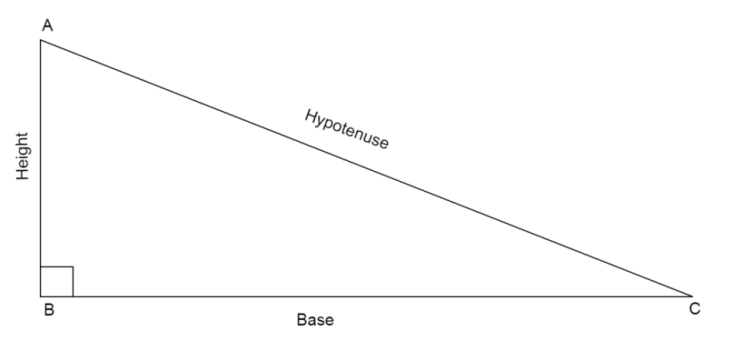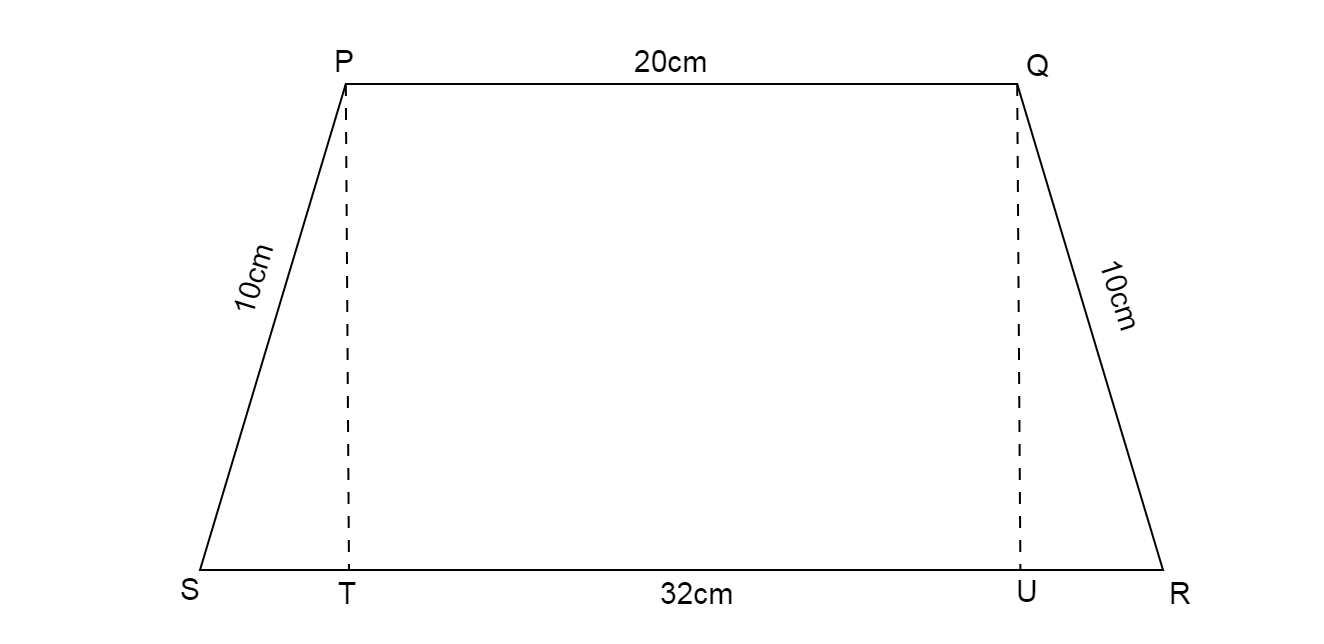
The parallel sides of a trapezium are 20cm and 32cm. Its non-parallel sides are 10cm each. The area of the trapezium is
A. 144
B. 108
C. 208
D. 416
Answer
474.9k+ views
Hint: We draw a diagram of the trapezium and calculate the height of the trapezium using Pythagoras theorem in a triangle formed with one of the non-parallel sides. Use the formula of the area of trapezium to calculate the area.
* Pythagoras theorem states that in a right angled triangle, the sum of square of base and square of height is equal to square of the hypotenuse. In the right triangle the largest side opposite to the right angle is the hypotenuse.
If we have a right angled triangle,

Then using the Pythagoras theorem we can write that
* Trapezium: A quadrilateral having one pair of opposite sides parallel is called a trapezium
* Area of trapezium having parallel sides ‘a’ and ‘b’ with height ‘h’ is given by
Step-By-Step answer:
We draw the diagram of the trapezium with given dimensions.
Parallel sides have lengths 20cm and 32cm.
Non parallel sides are equal in length as 10cm.
Draw a line representing height of the trapezium.

We have PQRS as a trapezium.
We draw altitudes from P and Q to the side SR.
Since PT and QU are altitudes, then the side TU becomes equal in length to side PQ
Also, the altitudes are equal in length, let us take
Now in triangles PST and QUR, since pairs of two sides are equal in lengths then it is confirmed that the length of the third side will also be equal.
Now we calculate the length of ST.
We know
Break the side SR in three parts i.e.
Substitute the value of
Cancel 2 from both sides of the equation
Shift all constants to RHS
So, the length of side
Now since
Substitute the values of
Shift all constant values to one side
We can write
Take under root on both sides of the equation
Cancel square root by square power on both sides
So, the height of the trapezium is 8cm
Now we calculate the area of trapezium PQRS
Since we know area of trapezium having parallel sides ‘a’ and ‘b’ with height ‘h’ is given by
Here value of
Cancel same factors from numerator and denominator
Note: Many students make the mistake of assuming the quadrilateral formed inside with altitudes and parallel sides as a square which is wrong, keep in mind we are not given that the altitude forms a square. Students are likely to make mistakes while applying Pythagoras theorem as many students write any side on any side of the equation, keep in mind the hypotenuse (largest side) is on one side of the equation and base and perpendicular are on the other side of the equation.
* Pythagoras theorem states that in a right angled triangle, the sum of square of base and square of height is equal to square of the hypotenuse. In the right triangle the largest side opposite to the right angle is the hypotenuse.
If we have a right angled triangle,

Then using the Pythagoras theorem we can write that
* Trapezium: A quadrilateral having one pair of opposite sides parallel is called a trapezium
* Area of trapezium having parallel sides ‘a’ and ‘b’ with height ‘h’ is given by
Step-By-Step answer:
We draw the diagram of the trapezium with given dimensions.
Parallel sides have lengths 20cm and 32cm.
Non parallel sides are equal in length as 10cm.
Draw a line representing height of the trapezium.

We have PQRS as a trapezium.
We draw altitudes from P and Q to the side SR.
Since PT and QU are altitudes, then the side TU becomes equal in length to side PQ
Also, the altitudes are equal in length, let us take
Now in triangles PST and QUR, since pairs of two sides are equal in lengths then it is confirmed that the length of the third side will also be equal.
Now we calculate the length of ST.
We know
Break the side SR in three parts i.e.
Substitute the value of
Cancel 2 from both sides of the equation
Shift all constants to RHS
So, the length of side
Now since
Substitute the values of
Shift all constant values to one side
We can write
Take under root on both sides of the equation
Cancel square root by square power on both sides
So, the height of the trapezium is 8cm
Now we calculate the area of trapezium PQRS
Since we know area of trapezium having parallel sides ‘a’ and ‘b’ with height ‘h’ is given by
Here value of
Cancel same factors from numerator and denominator
Note: Many students make the mistake of assuming the quadrilateral formed inside with altitudes and parallel sides as a square which is wrong, keep in mind we are not given that the altitude forms a square. Students are likely to make mistakes while applying Pythagoras theorem as many students write any side on any side of the equation, keep in mind the hypotenuse (largest side) is on one side of the equation and base and perpendicular are on the other side of the equation.
Recently Updated Pages
Master Class 9 General Knowledge: Engaging Questions & Answers for Success

Master Class 9 English: Engaging Questions & Answers for Success

Master Class 9 Science: Engaging Questions & Answers for Success

Master Class 9 Social Science: Engaging Questions & Answers for Success

Master Class 9 Maths: Engaging Questions & Answers for Success

Class 9 Question and Answer - Your Ultimate Solutions Guide

Trending doubts
Fill the blanks with the suitable prepositions 1 The class 9 english CBSE

Difference Between Plant Cell and Animal Cell

Given that HCF 306 657 9 find the LCM 306 657 class 9 maths CBSE

The highest mountain peak in India is A Kanchenjunga class 9 social science CBSE

What is the difference between Atleast and Atmost in class 9 maths CBSE

What is pollution? How many types of pollution? Define it




